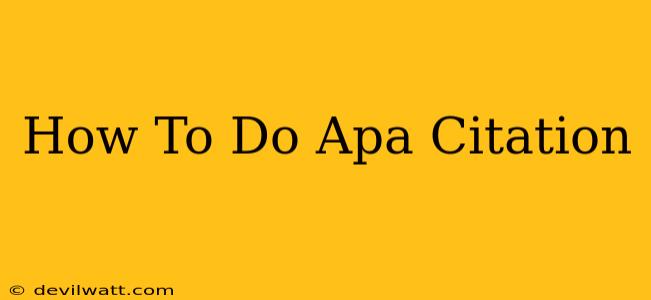Proper citation is crucial for academic integrity. Avoiding plagiarism and giving credit where it's due is paramount in any academic setting. This guide will walk you through the essentials of APA (American Psychological Association) citation, covering both in-text citations and the References page.
Understanding APA Style
The APA style is widely used in the social sciences, humanities, and education. It emphasizes clarity, conciseness, and consistency in referencing sources. The core principle is to provide enough information for the reader to locate the source easily. This includes author, date, and source details.
Key Components of an APA Citation
Regardless of the source type (book, journal article, website, etc.), several key components consistently appear in APA citations:
- Author: The person or organization responsible for creating the work. If multiple authors exist, list them in the order they appear on the source.
- Date: The year of publication. If the source doesn't have a publication date, use "n.d." (no date).
- Title: The title of the work. Capitalize only the first letter of the first word, the first letter after a colon, and proper nouns. Italicize titles of books and journals.
- Source Information: This varies depending on the source type and includes details such as publisher, journal name, volume number, page numbers, DOI (Digital Object Identifier), or URL.
In-Text Citations: Giving Credit Within Your Writing
In-text citations briefly acknowledge your sources within the body of your paper. They typically include the author's last name and year of publication.
Examples of In-Text Citations:
- One Author: (Smith, 2023)
- Two Authors: (Smith & Jones, 2023)
- Three or More Authors: (Smith et al., 2023) ("et al." means "and others")
- Direct Quote: "Direct quote" (Smith, 2023, p. 123). Note the page number for direct quotes.
- Multiple Sources: (Smith, 2023; Jones, 2024).
The References Page: A Complete List of Your Sources
The References page is a separate page at the end of your paper that provides complete bibliographic information for all sources cited in your text. It's alphabetized by the first author's last name.
Formatting the References Page:
- Hanging Indent: The first line of each entry is flush left, and subsequent lines are indented.
- Alphabetical Order: Arrange entries alphabetically by the first author's last name.
- Consistent Formatting: Maintain consistency in punctuation, capitalization, and spacing throughout.
APA Citation Examples by Source Type
Here are some common source types and their corresponding APA citation formats:
Journal Article:
In-text: (Smith, 2023)
References: Smith, J. (2023). Title of article. Title of Journal, Volume(Issue), pages. https://doi.org/xx.xxxx/xxxx
Book:
In-text: (Smith, 2023)
References: Smith, J. (2023). Title of book. Publisher.
Website:
In-text: (Smith, 2023)
References: Smith, J. (2023, Month Day). Title of web page. Website Name. URL
Note: These are simplified examples. The specific details required for each source type may vary depending on the information available. Always consult the official APA Publication Manual for the most up-to-date and comprehensive guidelines.
Mastering APA Citation: Tips for Success
- Start Early: Don't leave citations until the last minute. It's easier to manage them as you go.
- Use a Citation Management Tool: Tools like Zotero or Mendeley can help you organize and format your citations.
- Double-Check Your Work: Carefully review your citations for accuracy and consistency before submitting your paper.
- Consult the APA Manual: The official APA Publication Manual is the ultimate authority on APA style.
By following these guidelines, you can ensure your work meets the standards of academic integrity and presents your research effectively. Accurate and consistent APA citation demonstrates your credibility and professionalism as a researcher.

